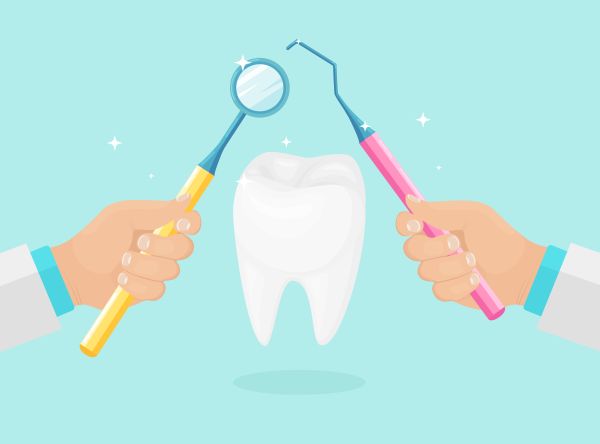How Dental Implants Anchor a Replacement for Missing Teeth

Dental implants provide the best anchor for crowns, bridges and dentures. If you have a missing tooth or teeth, your dentist should offer you several options for replacing them. Traditionally, bridges or dentures were the only choices when it came to replacing missing teeth. But, thanks to advancements in dental restorations, you can now choose replacements that will be permanent.
What are dental implants?
Dental implants are small devices that look like screws. Dentists use them to replace the roots of missing teeth and anchor teeth replacements.
Implants consist of three parts:
- the post — which anchors the implant in your jawbone
- the abutment — which screws into the post and connects it with the final part,
- the crown, the false tooth custom-made to replace the missing tooth.
How dental implants fuse with the jawbone
Most dental implants are made of titanium or titanium alloys. Titanium is biocompatible. It resists the body’s attempts to reject it and it does not cause inflammation or infection in the body. Once the titanium post is inserted into the jawbone, the bone cells grow on the surface of the post and actually into the microscopic holes in the surface. Over a period of months, living bone grows onto, into, through, and around the titanium post, fixing it firmly into the bone and eliminating instability.
How dental implants work as anchors
The beginning of the process is the same regardless of which restoration a patient is having anchored to the implant. The surgeon will place the post portion of the dental implant into their jawbone in a surgical procedure. After the bone fuses securely with the implant post, the dentist will complete the rest of the process.
Crowns
Using a dental implant to anchor a single crown replacement is the simplest of the restoration processes. After the post is secure, the dentist will reopen the gum and attach the abutment. They will then take measurements and possibly molds to custom-make a crown to replace the missing tooth.
Bridges
Bridges replace multiple missing teeth between remaining natural teeth. Traditionally, bridges are attached to the adjacent teeth by removing the enamel from the teeth and fitting them for crowns. The dentist attaches crowns to false teeth and fits them over the adjacent teeth to “bridge-the-gap” left by the missing teeth. Dental implants remove the need to use adjacent teeth. The surgeon places two implants in the gap. When the implants are secure, the dentist orders the crowns and attaches them. The dentist places the crown directly on the implant rather than on the adjacent teeth, providing a more stable anchor.
Dentures
Dentists even offer implant-supported dentures. For these restorations, the surgeon places a limited number of implants in strategic locations in the mouth. False teeth “fill the gaps” and crowns fit on each implant. When the implants are ready, the dentist secures the devices and gives the patient a brand-new smile.
Are dental implants right for you?
No matter why you need to replace a missing tooth or teeth, dental implants offer the best choice for anchoring your dental restoration. They are durable and dependable. The Mayo Clinic reports a 98 percent success rate nationwide for dental implant procedures. Implants are also more affordable in the long term because you will not have to reline or replace them. Give us a call today and let us give you a great smile!
Request an appointment here: https://dragonflydentalportcharlotte.com or call Dragonfly Dental of Port Charlotte at (941) 676-9225 for an appointment in our Port Charlotte office.
Check out what others are saying about our services on Google: Read our Google reviews.
Related Posts
A lot of general dentistry care is focused on the prevention of tooth decay. It is a common issue, and one that can be reversible in the early stages; however, if left untreated, it can become serious. Knowing the signs of tooth decay and understanding the risks of not giving it the proper care can…
Finding a qualified general dentistry professional is an important task made more difficult if the thought of visiting the dentist causes anxiety, as it does for so many people. Remember that the dentist you choose will serve as an important partner for your oral health and overall wellness, as poor oral hygiene can lead to…
Most people understand that brushing and flossing are the basics of good oral hygiene, but general dentistry professionals say there is much more you can do to ensure your mouth remains healthy throughout your life. Strong teeth and gums allow you to communicate easily, enjoy good food, and avoid the pain and embarrassment associated with…
A tooth abscess is one of the most serious problems treated in general dentistry. It occurs due to an infection in the tooth or gums. The body sends white blood cells to the site to fight the infection. These form a yellowish-white fluid called pus. An abscess occurs when a pocket of pus forms in…
